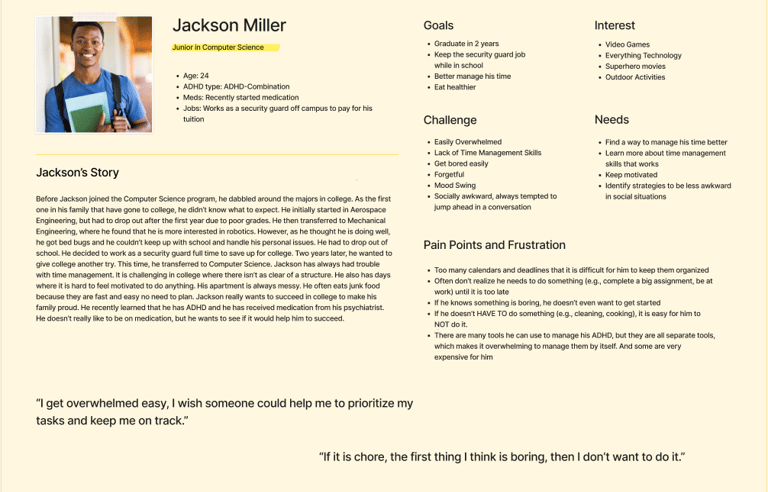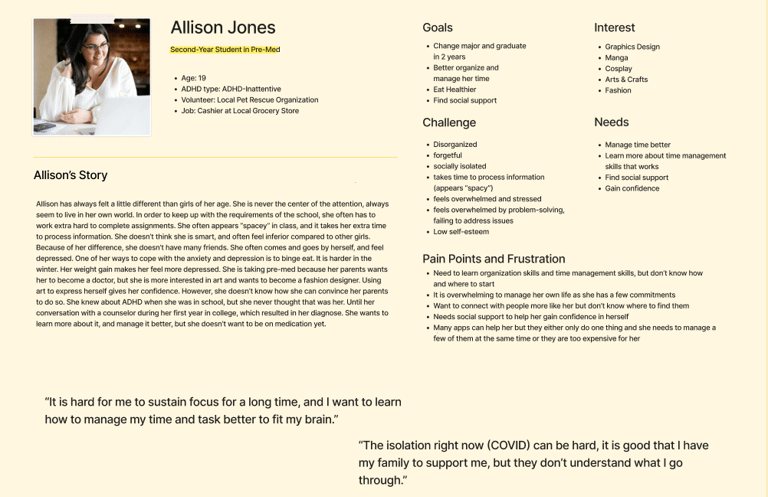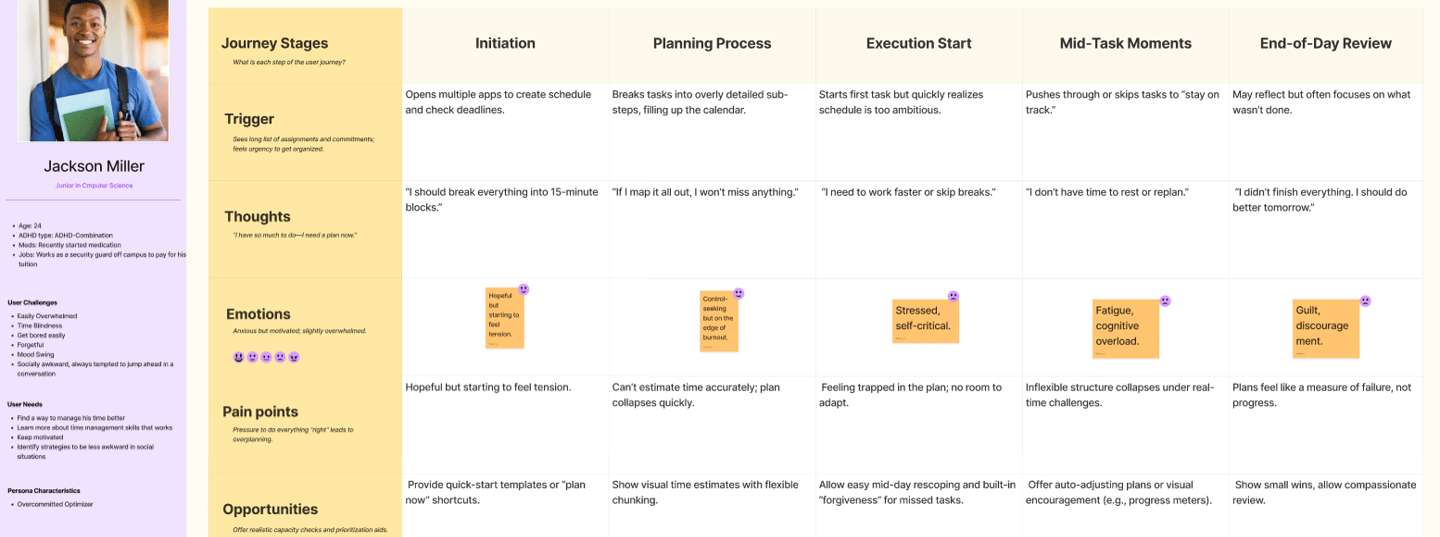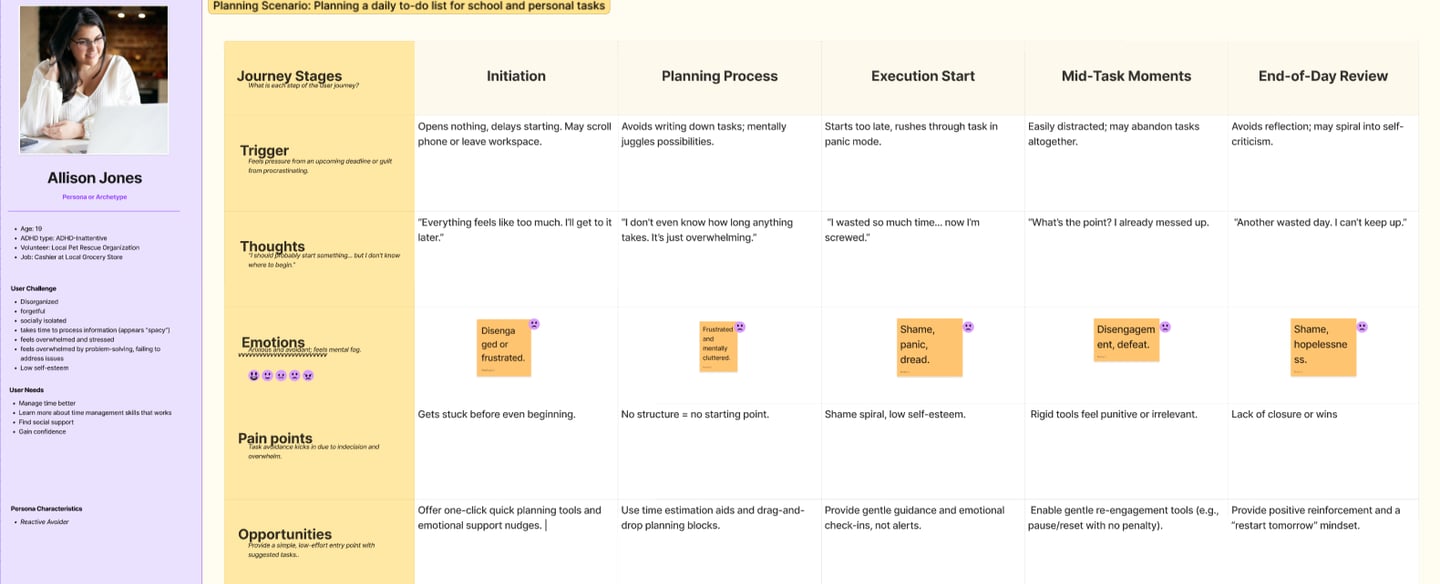UX Skill Development
Personas and Journey Map Development for ADHD Time Management
Overview
We explored how adults with ADHD manage time and structure their daily routines. My goal was to practice core UX research skills—specifically user interviewing, qualitative synthesis, and persona and journey map development—to better understand a population often underserved by traditional productivity tools. This self-initiated class project that I did early in my UX journey.
Through interviews and thematic analysis, I developed two distinct personas to illustrate patterns in time management behaviors, challenges, and coping strategies. These personas can be used to guide future design decisions in EdTech, mental health, and productivity tools.
The Problem
Adults with ADHD often struggle with conventional time management strategies, yet most productivity apps assume linear, neurotypical workflows. This gap presents an opportunity to reimagine tools that support nonlinear routines, task switching, and motivation management.
My research asked:
How do adults with ADHD actually approach time, structure, and planning?
What can designers learn from that?
My Role
I led all aspects of the research in this project, including:
Designing and conducting user interviews
Analyzing qualitative data through affinity mapping
Creating personas grounded in real behaviors and emotional drivers
Synthesizing findings into actionable design considerations
Research Process
To understand how adults with ADHD navigate time management, I conducted research combining user interviews, literature review, and competitive analysis.
Conducted a literature review on ADHD-specific executive functioning challenges, motivation regulation, and common breakdowns in planning systems.
Analyzed popular time management tools, comparing those designed for the general population with those marketed specifically for ADHD users, to identify key usability gaps and unmet needs.
Led 1:1 semi-structured interviews with five adults diagnosed with ADHD, exploring their daily routines, time-tracking strategies, tool usage, and emotional responses to planning and task execution.
This research revealed deep emotional friction around time planning—often shaped by past failures, shame, or cognitive overload. These insights directly informed the development of behaviorally grounded user personas and highlighted design opportunities for more flexible, compassionate productivity tools.
Synthesis & Insight Development
Following the interviews, I used affinity mapping to analyze qualitative data and identify recurring behaviors, emotional drivers, and time management strategies. Our research confirmed several well-documented challenges experienced by adults with ADHD, particularly among undergraduate students. Through qualitative interviews with six students (4 men, 2 women), we validated the following persistent issues:
Difficulties prioritizing tasks and initiating work
Time blindness, or difficulty estimating how long tasks take
Impulsivity and frequent distractions
Emotional dysregulation and motivation drops when plans fail
Overcommitment and disrupted routines
Co-occurring anxiety and depression, which compound planning difficulties
In addition, our research uncovered product-relevant insights specific to time management app usage and unmet needs.
Tool Fragmentation & Overload
Participants often used multiple apps to manage different aspects of their time, but found it overwhelming to track tools that are supposed to reduce overwhelm. Few tools integrated well with the systems students were already required to use (e.g., learning platforms, calendars).Planning Tools Can Become a Barrier
Many apps required users to pre-plan tasks in detail, which added cognitive and emotional strain. When users couldn’t accurately estimate time—due to ADHD-related “time blindness”—they often abandoned the tools altogether.Need for Flexibility & Reprioritization
Participants expressed a strong need for tools that support task chunking, easy reprioritization, and persistent yet nonjudgmental reminders—especially when attention shifts unexpectedly.Emotional Support & Rapport Matter
Social accountability tools worked best when they included people who understood ADHD-specific struggles. Emotional rapport was crucial during periods of low motivation or burnout.Ongoing Learning is Part of the Strategy
Participants who were actively learning about ADHD and executive functioning reported better coping strategies. They saw personal education as an ongoing tool for managing their condition.
These themes revealed the complex, emotional nature of time management for ADHD users, and challenged assumptions baked into many traditional productivity tools. The synthesis not only informed the development of nuanced user personas but also pointed to opportunities for designing tools that are more flexible, provide emotional support, and integration with existing academic systems—rather than relying on rigid workflows that assume linear planning or consistent motivation.
Persona Development
To translate qualitative insights into actionable design direction, I developed two behavior-based personas grounded in patterns identified through affinity mapping and interview analysis. These personas capture distinct mental models, motivational barriers, and tool interaction styles commonly observed among students with ADHD.
The Overcommitted Optimizer is ambitious and structured, but struggles with time blindness, overplanning, and emotional burnout when expectations aren’t met.
The Reactive Avoider resists structure, avoids task initiation, and relies on emotional urgency to complete work—often cycling between procrastination and panic.
Each persona reflects different planning behaviors, emotional triggers, and support needs, offering product teams a lens to design flexible, compassionate, and ADHD-responsive time management tools. By grounding personas in real data, I was able to communicate complex user needs in a format that helps cross-functional teams empathize with users and make more informed design decisions.




Journey Map Development
To deepen my understanding of how students with ADHD engage with time management tools, I developed two comparative journey maps based on the personas from this project: The Overcommitted Optimizer and The Reactive Avoider. While both face challenges with focus, planning, and follow-through, their behaviors, emotional triggers, and coping strategies differ significantly.
Each map traces the step-by-step experience of planning and executing a daily to-do list—from the initial trigger to end-of-day reflection. I mapped not only actions, but also internal thoughts, emotional states, pain points, and design opportunities across each stage.
This exercise helped me translate research insights into tangible design guidance, highlighting where interventions like adaptive planning, positive reinforcement, and flexible task structuring could better support neurodiverse users. It also demonstrates my ability to apply user research to behavioral modeling, opportunity mapping, and inclusive design strategy.




Design Implications
Based on the journey maps, we identified key opportunities to improve time management tools for students with ADHD by addressing both functional and emotional needs. These design implications emphasize flexibility, clarity, and motivation support:
Design for Cognitive Flexibility
Rigid planning tools can break under the pressure of ADHD-related time blindness and shifting focus. Tools should allow users to easily reprioritize, adjust scope, and reschedule tasks without penalty.Reduce Planning Friction
Many participants struggled just to get started. Interfaces that offer low-effort planning templates, visual task chunking, and smart defaults can help users overcome initiation barriers.Integrate Emotional Scaffolding
Shame and discouragement are common when plans fail. Products should offer nonjudgmental feedback, celebrate small wins, and create space for users to restart without guilt.Personalize the Experience Since no two ADHD users plan the same way, adaptive features (e.g., mode switching for structured vs. spontaneous workflows) can improve usability and extend tool relevance over time.
By translating these findings into product strategy, I demonstrated how qualitative research can inform not just feature design—but inclusive, resilient systems that better reflect real human behavior.
What I Learned
This project strengthened my ability to design for users whose needs don’t align with traditional productivity tools—particularly those with neurodiverse cognitive and emotional patterns.
I learned how to uncover not just what users do, but why they struggle, and how that struggle affects tool adoption, emotional wellbeing, and long-term success.
Key Takeaways:
Rigid systems can backfire
Productivity tools that demand detailed planning often increase cognitive load, leading to avoidance, burnout, or shame.Behavioral insights must be emotional too
Emotional friction—like guilt, overwhelm, and time blindness—is just as important as usability.Persona and journey mapping are powerful alignment tools
Modeling two distinct ADHD user types helped communicate needs across design, research, and product thinking.Design must account for adaptability and self-forgiveness
Features like rescoping, gentle reminders, and flexible planning flows can turn a broken plan into a recoverable experience.Inclusive design requires real-world nuance Working from qualitative data helped me move beyond assumptions and advocate for more compassionate, human-centered systems.
This experience deepened my perspective on how UX research can drive meaningful, inclusive innovation—especially when working with complex user needs.
